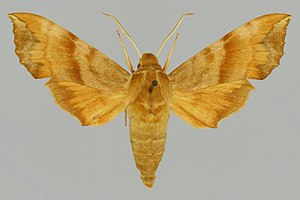Clarina syriaca
| Clarina syriaca | ||||||||||||
|---|---|---|---|---|---|---|---|---|---|---|---|---|

Clarina syriaca , male |
||||||||||||
| Systematics | ||||||||||||
|
||||||||||||
| Scientific name | ||||||||||||
| Clarina syriaca | ||||||||||||
| ( Lederer , 1855) |
Clarina syriaca is a butterfly ( moth ) from the family of moth (Sphingidae). According to Kitching & Cadiou (2000), the species is a sister speciesof Clarina kotschyi , but Pittaway only regards it as a subspecies of Clarina kotschyi . The species is thought to have originated from isolation in the Levant region and spread to northern Turkey after the last Ice Age, where itformed hybridswith Clarina kotschyi , which occurs there and which spread further west. In Turkey it is sometimes difficult to clearly assign individuals to one of the two species.
features
The moths have a wingspan of 50 to 65 millimeters and are therefore significantly smaller than Clarina kotschyi . They are similar to the pine moth ( Dendrolimus pini ; family Lasiocampidae ). The species is quite variable in appearance. The basic color varies from deep reddish brown to pale gray. The oblique lines on the forewings are very pale in some animals, and the outer edge of the forewing can sometimes be formed without indentations. There is a clear sexual dimorphism between the sexes . The males are lighter in color and also smaller than the females.
The caterpillars are 55 to 65 millimeters long and are very similar to those of Clarina kotschyi . Only in newly hatched caterpillars can the anal horn be either dark gray or pink-orange. The oval eggs are flattened dorsoventrally. They are pale yellowish green. The doll is 30 to 36 millimeters long. It is almost identical to that of Clarina kotschyi , but more pigmented.
Occurrence and habitat
The species occurs from the north of Turkey in the south to the north and west of Syria, Lebanon, the north of Jordan and in Israel. It has been proven in Cyprus with a single find from 1950 in Platres . In the south of Turkey the species seems to have recently spread further west and occurs there as far as Antalya . It populates agriculturally used valleys with rivers that have plenty of scree and border trees and bushes on which vines grow. The species is often found in large numbers in such places. The animals can also be found on slopes in mountain valleys with bushes and isolated trees and also in vineyards. In Lebanon the species has been proven up to 1000 meters above sea level. In southern Turkey, the species is widespread in the valleys at the foot of the Taurus Mountains , where the mountains rise from the lowlands near the coast, but is absent there in the lowlands. The animals are often found on houses and farms with pergolas with grapevines.
Way of life
Flight and caterpillar times
The moths fly in two generations per year depending on the populated altitude from May to early July and in September and October. The caterpillars can be seen in June and July and again in September and October.
Food of the caterpillars
The caterpillars feed on grapevines ( Vitis ) and virgin vines ( Parthenocissus ). Away from human settlements, the animals prefer the grapevine ( Vitis vinifera ) when it grows over rock walls, cliffs or trees.
development
The females lay their eggs individually on the upper side of the leaves of the host plants. It is not uncommon to find the eggs together with those of Theretra alecto , which are, however, larger. Well-known parasitoids of the species are the ore wasp Anastatus bifasciatus and the caterpillar flies Compsilura concinnata and Drino imberbis .
